Accessible Transit
Accessible Features
Winnipeg Transit continues to work towards improving accessibility for all passengers.
An overview of features and tips for passengers with disabilities travelling on conventional transit is available in PDF format.
The following features are currently in place:
- Low floor easy access buses
- Automated external announcements
- Next stop announcer and visual stop display
- Priority and Courtesy Seating
- Adjustable seating options
- Operator assistance provided upon request
- Wheelchair and scooter securement systems
- Travel Training program
- Other important information
Low floor easy access buses
All buses in Winnipeg Transit’s fleet are low floor easy access. This means the buses are all capable of kneeling to the curb and lowering a ramp at the entrance, with no stairs at the front or rear doors.
All passengers can request that the Operator kneel the bus or lower the ramp at any time to assist with boarding or exiting the bus.
All buses kneel to within inches of standard curb height. This allows for near level boarding and reduces the height to enter the bus.
Kneeling bus close to curb

The ramp is controlled by the Operator and will be lowered for all passengers travelling with mobility aids or for those passengers who request the ramp be lowered. The ramp extends out from the front door of the bus. All ramps have a grip tape surface to prevent slipping in wet and snowy conditions.
Electric ramp fully deployed
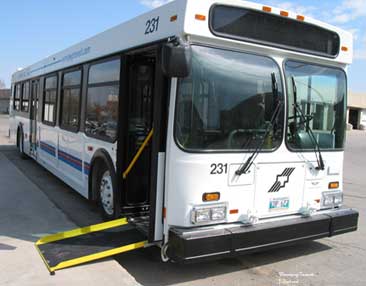
Automated external announcements
The majority of buses in Winnipeg Transit’s fleet provide automated external announcements that share route information when arriving at a bus stop.
Next stop announcer and visual stop display
Informs passengers of upcoming stops by making an audible announcement and displaying the name of the upcoming stop on a display located near the front of the bus.
This may be helpful to passengers:
- When travelling to unfamiliar areas
- When travelling at night and street signs and landmarks are not visible
- Who may have visual impairments of hearing impairments
Priority and Courtesy Seating
Winnipeg Transit’s new Priority and Courtesy Seating Area Policy goes into effect October 5, 2022. All passengers are strongly encouraged to learn more about their role in helping ensure public transit is accessible for all, before this change takes place.
All passengers must work together to help ensure persons with a disability have equitable access to transit as outlined under the Policy, and be mindful of others who benefit from a seat near a door. Be aware of these areas on the bus and be prepared to offer your seat to someone in greater need:
Priority Seating Area – Designated for passengers with a disability.
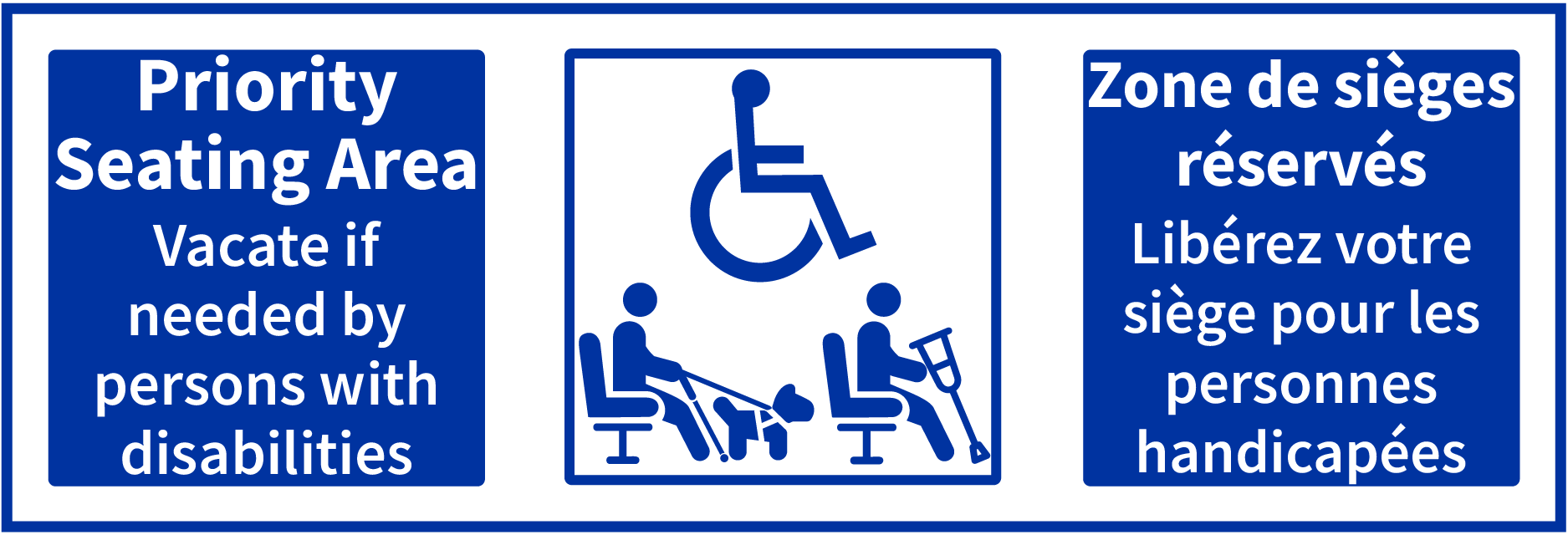
The priority seating area is located at the front of the bus and is available to passengers with both visible and invisible disabilities. It includes features to accommodate passengers with wheelchairs and scooters, such as seats that flip up and securement stations. Passengers who don’t have disabilities are asked to sit elsewhere.
- When a passenger with a visible or invisible disability who requires a seat in the priority area boards a bus, passengers who don’t have a disability sitting in that area will be asked to move to another location on the bus. The operator will play an automated message with this request, and if necessary, may also remind other passengers directly to vacate the area.
- A passenger with a disability is not required to move to make space for another passenger with a disability, however, if a mobility aid securement space is needed, they may be encouraged to move to alternate seating, as wheelchair or scooter users may not be able to access the bus otherwise.
- There is no requirement for any passenger to leave a transit vehicle in order to make room for a passenger with a disability.
- Bus operators are not responsible for enforcement.
Transit passengers using wheelchairs/scooters positioned in the mobility aid securement spaces will ensure that the mobility aids:
- have wheel locks and that they are engaged or power is turned off,
- do not impede the aisles; all aisles must be kept clear at all times,
- proper securement at anchor points using the securement systems located in the priority seating area is recommended.
To ensure they can fit on the ramp, clear the bus entrance, be safely positioned and properly secured, wheelchairs and scooters must be within the following size guidelines: 28 inches in width, 48 inches in length. For safety reasons the maximum weight that can be accommodated on the ramps is 272 kg/600 lbs.
Courtesy Seating Area – For others who benefit from being seated near the door.
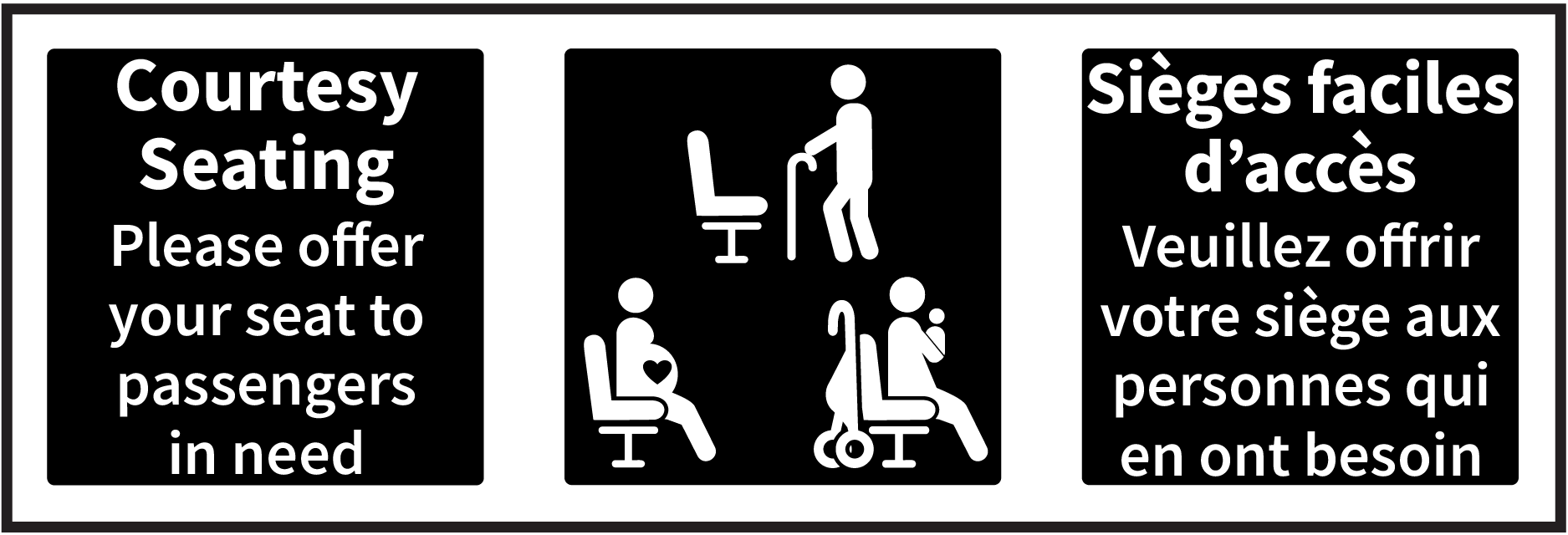
The courtesy seating area includes the forward-facing seats located closest to the priority seating area.
Passengers who may use the courtesy seating area include but are not limited to seniors, those who are pregnant, and those travelling with young children.
- Courtesy seating is available on a first-come, first-served basis
- Bus operators will not enforce or intervene on disputes over use of the courtesy seating area.
Transit passengers will ensure that strollers:
- are foldable and can be stored, if necessary,
- do not impede the aisles; all aisles must be kept clear at all times, and
- are able to engage wheel locks where appropriate when on the bus.
Priority and Courtesy Seating FAQs
Accessible boarding
Passengers are asked to wait at bus stops to allow passengers with disabilities to board the bus before other passengers, and to allow for bus operators to assist upon request.
Request Stop Button
If a passenger seated in this area uses a stop request bell button located on the underside of a flip-seat, the Operator will be made aware that someone seated in a priority seating area is getting off at the next stop.
Push button to request next stop
Adjustable Seating Options
Seating in the front of the bus allows for a variety of seating options to accommodate passengers including those who may be travelling with a mobility aid or stroller.
Seats can be flipped up either by lifting with a hand anywhere along the edge of the seat or on some models by pulling on a lever or knob underneath the seat.
Once the seat is lifted halfway up, the seat will balance, the passenger can reposition their hand and lift up seat the rest of the way.
The ability to flip up seats provides options for passengers to keep mobility aids and strollers out of the aisle – please ensure the aisle is kept clear so other passengers can board the bus.
Operator assistance provided upon request
Starting in spring 2021, Winnipeg Transit will begin providing service to passengers on new buses which include two new types of securement systems for wheelchairs and scooters. These are referred to as the Quantum and Q’Pod.
These buses will be designated with a decal featuring the image below, located outside the front door and in the Priority Seating Area.
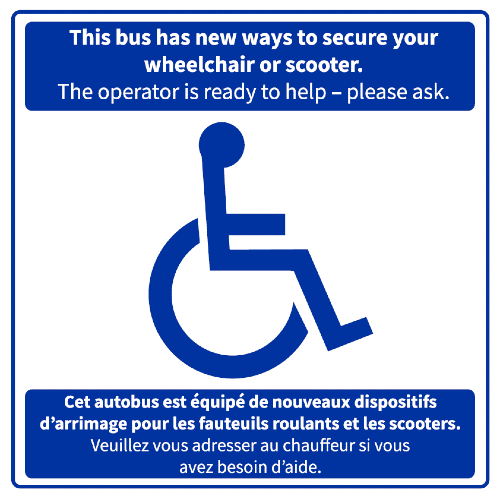
The designated buses will also be identifiable on Navigo. To find buses with new securement systems and Operators who are trained and ready to assist with new securements, look for the icon on bus schedules:

Operators on these designated buses have received training on assisting passengers with boarding and exiting the bus and also with how to assist with these new securement systems. Operators will ask passengers if they require assistance with boarding or exiting the bus and with securing wheelchairs and scooters using the Quantum or Q’Pod.
As part of Winnipeg Transit’s ongoing commitment to safety and providing accessible and equitable service, additional policies regarding Operator assistance and securement of mobility aids is being phased in.
In the current phase, Operators on designated buses have been trained and are ready to assist customers with securement with the Quantum and Q’Pod.
In future phases, all Operators will be trained on how to assist passengers using every variety of securement system on Winnipeg Transit buses. Once that has been completed, securement will be required on all buses. These changes are being made in anticipation of the Transportation Standard under the draft Accessibility for Manitobans Act.
On older buses (e.g. those that do not have the decal or the Quantum/Q’Pod) Operators are to:
- Ensure that the passenger travelling with a wheelchair or scooter is positioned in one of the designated positions
- Provide sufficient time for securement of their wheelchair
- Request that all passengers apply the wheel lock of their manual wheelchair or turn off power on power wheelchairs and scooters
- Provide information about the securement system when asked
Passengers are encouraged to secure their wheelchair or scooter when travelling using the securement system available on the bus. Unsecured wheelchairs or scooters pose a safety risk not only to the passenger but also to other passengers and the Operator.
Currently, if a passenger cannot or chooses to decline the securement of their wheelchair or scooter, the Operator may proceed with service as long as the mobility aid is positioned in one of the two designated locations, with the wheel lock applied or power turned off.
Travelling on Winnipeg Transit with Mobility Aids
Canes/Crutches
Ask the Operator to kneel the bus or lower the ramp. Position yourself safely away from the bus if using the ramp.
Keep your mobility aid close to you when travelling and ensure the aisle is clear.
Walkers
Ask the operator to kneel the bus or lower the ramp, if required. Position yourself safely away from the bus if using the ramp.
If possible flip up the seats in the Priority Seating Area for walker storage, or fold your walker, to ensure the aisle is clear.
Manual Wheelchairs
Ask the operator to kneel the bus or lower the ramp. Position yourself safely away from the bus if using the ramp.
The width of the ramp is 30”.
Check the dimensions of your manual wheelchair before travelling:
- Measure the width of your wheelchair from outside rim to rim. If your wheelchair is greater than 28” in width you will be unable to access the bus. To safely access the bus using the ramp you will require a minimum of 1” on either side of your wheelchair.
- Measure the total length of your wheelchair. If your wheelchair length is more than 48” you will have difficulty making the turn upon entering the bus and also positioning the wheelchair in the designated location.
If you are travelling with a backpack or bag on your wheelchair, please consider the size, dimensions and if it can be repositioned during travel as this may impact your ability to use a securement system.
Apply your wheel lock.
Power Wheelchairs
Ask the operator to kneel the bus or lower the ramp. Position yourself safely away from the bus if using the ramp.
The width of the ramp is 30”.
Check the dimensions of your power wheelchair before travelling.
- Measure the width of your wheelchair from widest point to point. If your wheelchair is greater than 28” in width you will be unable to access the bus. To safely access the bus using the ramp you will require a minimum of 1” on either side of your wheelchair.
- Measure the total length of your wheelchair. If your wheelchair length is more than 48” you may have difficulty making the turn upon entering the bus and also positioning the wheelchair in the designated location. Ensure the battery on your power wheelchair is fully charged before travelling.
Adjust the speed of your power wheelchair to allow you to safely enter/exit the bus and maneuver your mobility aid.
If you are travelling with a backpack or bag on your wheelchair, please consider the size, dimensions and if it can be repositioned during travel as this may impact your ability to use the securement system.
Ensure your wheelchair is powered down.
Scooters
Ask the operator to kneel the bus or lower the ramp. Position yourself safely away from the bus if using the ramp.
The width of the ramp is 30”.
Check the dimensions of your scooter before travelling:
- Measure the width of your scooter from widest point to point. If your scooter is greater than 28” in width you will be unable to access the bus. To safely access the bus using the ramp you will require a minimum of 1” on either side of your scooter.
- Measure the total length of your scooter. If your scooter length is more than 48” long you may have difficulty making the turn upon entering the bus and also positioning the scooter in the designated location.
- Check the turning radius of your scooter- this can vary greatly between different types of scooter. This will greatly impact your ability to access the bus and designated securement locations.
Ensure the battery on your scooter is fully charged before travelling.
Adjust the speed of your scooter to allow you to safely enter/exit the bus and maneuver your mobility aid.
Ensure your scooter is powered down.
Securement systems for wheelchairs and scooters
The securement of wheelchairs and scooters is critically important for the safety of passengers who are travelling on Transit with their scooter or wheelchair and also for other passengers and the operator.
Wheelchairs and scooters can vary significantly in weight and dimensions. If these mobility aids are not secured during transportation they can pose a safety risk during accidents and routine driving.
All Winnipeg Transit Buses are equipped with securement systems for wheelchairs and scooters, but the type of system varies based on the model of bus. Passengers are encouraged to use these systems whenever possible and request assistance with instruction for use or securement.
Where?
- In standard length buses there are two designated wheelchair or scooter securement locations directly behind the front wheel wells
- On articulated buses these are located in the front section of the bus
Types of Wheelchair and Scooter Securement Systems on Winnipeg Transit
- Quantum
- Q’Pod
- Rear facing with upright pad
- Front facing with wheel lock
- Front facing with C-Clamp
- Front facing with securement belts
Always ensure your wheel lock is applied or power turned off on your wheelchair or scooter when travelling.
If there are no securement locations available in the Priority Seating Area on the bus you are attempting to board, you will need to wait for the next available bus.
Quantum
The Quantum is:
- A fully automatic securement system
- Rear facing
- Located street side
- Allows for operation by the passenger or the operator
- Quick securement in under 25 seconds
- Intended for use with scooters or wheelchairs which are between 19-30 inches wide


More information about the Quantum is available on the manufacturer’s website.
Watch this instructional video to familiarize yourself with the Quantum.
Instructions for use of the Quantum can also be found on the bus.
Important information when using the Quantum:
- Indicate to the Operator upon boarding if you would like to operate the Quantum on your own or if you would like the Operator to assist
- Center your wheelchair on the backboard and position your wheelchair as close as you can to the backboard. Remove any obstacles or barriers that impact your ability to position your wheelchair or scooter.
- Ensure you are facing the back of the bus.
- Always turn off power or apply your wheel locks.
- Check positioning of your wheelchair or scooter to ensure that the arm of the Quantum is pressing against the wheels of your mobility aid. If not, reposition.
- Passengers travelling with wheelchairs that have angled wheels are not recommended to use the Quantum as the arms of the Quantum may have difficulty securing properly.
Q’Pod
The Q’Pod is:
- A 3-point system which secures the wheelchair or scooter as well as the passenger during travel
- Front facing
- Located curb side
- Requires operator assistance for full securement system use
More information about the Q’Pod is available on the manufacturer’s website.
Instructions for the Q’Pod can also be located on the bottom side of the seats in the Q’Pod compartment area.


Important information when using the Q’Pod:
- Operator assistance is required with this securement system as the J-Hooks must be placed on specific locations on your wheelchair or scooter for full and safe securement.
- If you have a WC-19 wheelchair or a wheelchair with specified securement locations intended for transportation, please point out these locations to the Operator.
- Ensure you are facing the front of the bus.
- If able, please assist Operators by:
- Positioning your mobility aid in the securement area
- Applying wheel locks or turning off power
- Assisting with the shoulder and lap belt
Rear facing with upright pad
These forward facing securement locations can be used by manual wheelchairs, power wheelchairs or scooters.
To access the securement space, the bus seats must be flipped up.
How to use:
- Position your wheelchair or scooter against the upright pad
- Remove all bags or other objects that may be impacting your ability to position directly against the upright pad
On some buses you may also find an additional stabilizer belt located on the wall of the bus. Pass this seat belt around the arm rest of your mobility aid and buckle the belt. Ensure any loose seatbelt is recoiled and secured.
Front facing with wheel lock
The wheel lock securement system can only be used with manual wheelchairs. It is not recommended for use on manual wheelchairs with plastic components to their wheels, scooters or small diameter wheels.
To access this securement system, the forward-facing seat and aisle facing seats must be flipped up.
The wheel lock system is intended to also be used with an aisle side securement belt to ensure full securement of the wheelchair.
Wheel Lock

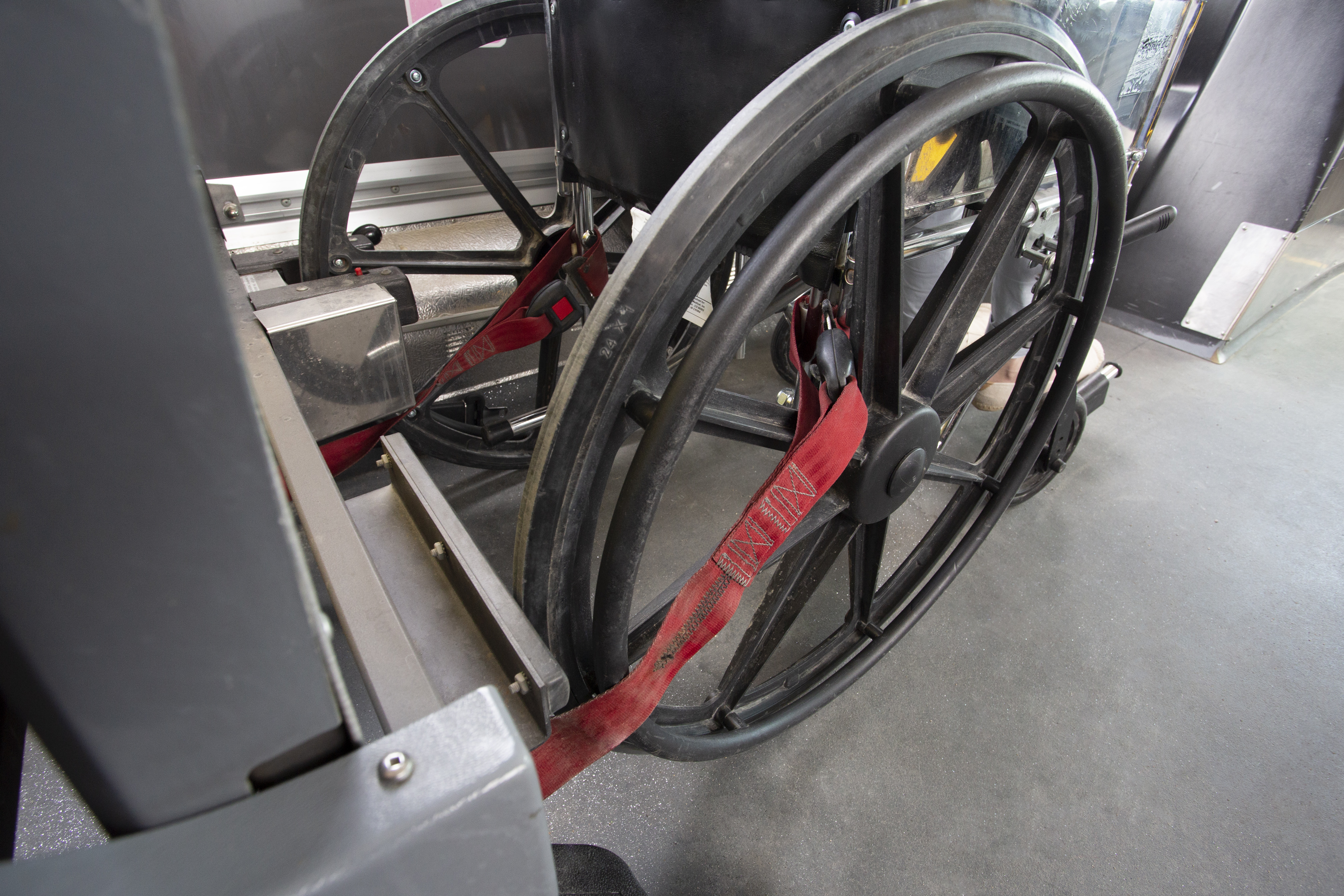
How to use:
- Push the lock release button to make sure the lock is open
- Position wheelchair facing front of bus and back rear wheel into lock
- When wheel firmly contacts the plate, the lock will close
- Ensure red indicator button is recessed and you are unable to move your wheelchair forward
- Apply red securement belt to aisle side solid frame member of wheelchair
- Extend both black lap belts to occupant’s aisle side hip area and fasten belt- do not place belts over wheelchair arm rests
- Apply wheel locks
How to release from this system:
- Press green button on bottom side of seat or use release lever
- Remove additional securement belt
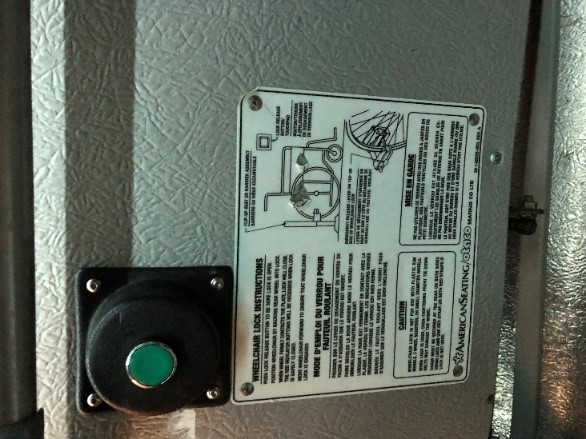
Front facing with c-clamp
The c-clamp securement system can only be used with manual wheelchairs and is not recommended for use on wheelchairs with plastic components. It is not to be used with scooters, power wheelchairs or manual wheelchairs with small diameter wheels.
To access, the forward-facing seat and aisle facing seats must be flipped up.
The c-clamp system is intended to be used also with an aisle side securement belt to ensure full securement of the wheelchair.
How to use:
- Ensure the clamp is in the open position by pushing the lock release lever
- Position wheelchair facing front of bus and back rear wheel into lock
- When wheel firmly contacts the plate, the lock will close.
- Ensure red indicator button is recessed and unable to move wheelchair forward
- Apply securement belt to aisle side of wheelchair
- Apply wheel locks
To release:
- Move the black handle (located near the wheel lock) up, down or to the side to release the c-clamp or press green release button on bottom of seats if available
- Remove additional securement belt
Front facing red securement belt system
This securement system can be used for all manual wheelchairs, power wheelchairs and scooters.
These red belts are to be attached to the frame of your mobility aid.
This system is used for those wheelchairs where it is not recommended to use the wheel lock or c-clamp.
How to use:
- Attach rear red belts to solid frame member on each side of the mobility aid
- Back mobility aid toward barrier then forward until red belts lock
- Apply wheel locks or turn off power
- Extend both ends of the lap belt to the aisle side hip area and fasten. Do not place belts over arm rests.
Travel Training program
Winnipeg Transit’s Travel Training program provides information and practical training sessions on Transit services (e.g. Conventional Transit, including On Request service, and Transit Plus).
Sessions are designed to meet the specific needs of an individual or group and can cover a variety of topics, including trip planning and traveling on transit with mobility aids or devices. Travel training may be beneficial to people who are new to Winnipeg or unfamiliar with Winnipeg Transit services, and others.
More information is available on the Travel Training program page.
Other Important Information
Travelling with Oxygen
When travelling with oxygen, ensure that you plan to bring enough oxygen that may be required for the full duration of your trip. Please know that from time to time unexpected circumstances may occur that can cause trip delays, and it is important to be prepared.
Travelling with Service Animals
Passengers are welcome to travel with service animals on the bus. Passengers are responsible for the care, supervision and control of the service animal at all times. Service animals are to remain on the floor near the owner or on the owner’s lap.



